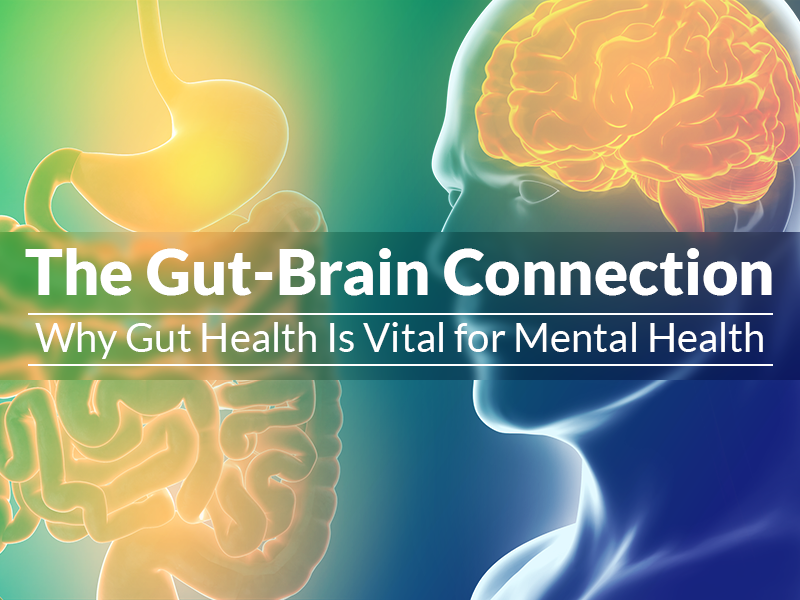Gut-Brain Connection: Why Gut Health Is Vital for Your Brain

The human body is incredibly complex and fascinating, and there is so much we’re learning — with so much more still to learn — about how it functions and how its systems interact with each other. Consider the gut-brain connection, for instance. Sure, many of us have heard things like, “Go with your gut” when making decisions, or “I had a gut feeling it would work out.”
But the gut doesn’t “think.” Or does it?
Well, there’s a good reason that the gut is now referred to as our “second brain.” And while it might not help us think in the same way our “first” brain does, it’s becoming clear that the gut has a powerful, intricate, and intimate connection with the brain, especially when it comes to emotions, mood, and pain. In fact, researchers believe that anxiety, pain, and depression can contribute to and be traced back to poor gut health.
What is the Enteric Nervous System (ENS)?
Within the digestive system lies the enteric nervous system (ENS), which consists of 2 thin layers of some 500 million nerve cells (i.e., “neurons”). (To put that into perspective, that’s roughly 5 TIMES more neurons than you’ll find in the spinal cord.) Yet unlike the “main” brain, you won’t find yourself using the second brain to do complex feats of math or find the location of the coolest gym.
Rather, its main role is for controlling digestion (via the release of enzymes to break down food along with controlling when to swallow), nutrient absorption, elimination, and blood flow throughout the large GI tract. Myelin (the insulating sheaths around nerves that increase the speed of communication) is also regulated by microbes (another name for microorganisms, like bacteria) in the gut. And as mentioned, the gut communicates back and forth with the brain (for the gut-brain connection), yet the gut is able to control the complexities of digestion independently.
While we’re often more likely to think of the bad bacteria (like E. coli, MRSA, or anthrax) in the environment, the majority of microbes in our lives are good for us. They reside in every part of our bodies, especially our gut and skin, and are known to protect us from germs and pathogens, help us get nutrients from the foods we eat, bolster the immune system, and support mood (decreasing levels of stress, anxiety, and depression).
And there may be consequences when there’s not enough variety (an example of “gut dysbiosis,” or an unhealthy balance of gut microbes), including an increase in autoimmune diseases (e.g., asthma and allergies), antibiotic resistance, and increased risk of inflammatory bowel disease, diabetes, and obesity.
Perhaps most interestingly of all, the microbes that make up our microbiome (made up of trillions of bacteria, viruses, and fungi residing in the gut) can produce neurotransmitters to communicate with the brain in the same language. For just one example, a probiotic known as Lactobacillus rhamnosus can favorably alter the activity of GABA, an inhibitory neurotransmitter that plays an important role in calming anxiety.
And surprisingly, 90% of the fibers in the vagus nerve carry info from the gut to the brain — not the other way around. In addition, 95% of the body’s serotonin (another neurotransmitter known for its influence on wellbeing and happiness) is found in the digestive tract.

Pit in the Stomach
When you’re feeling seriously stressed — say you have to give a presentation in front of a large audience or make a big decision for your job — you probably feel it in the pit of your gut. There is solid evidence that both psychology and psychosocial experiences affect the physiology of the gut. And it appears our emotions are largely influenced by the nerves in the gut, laying credence to the gut-brain connection.
Our reaction to stress influences the movement and contraction of our digestive tract, increases inflammation, and may also increase our vulnerability to infection with tell-tale signs like heartburn, cramps, and loose stools. Chronic stress can also compromise the gut microbiome — contributing to gut dysbiosis — and even single stressful events (like public speaking) increase intestinal permeability (also known as leaky gut).
And as many of us have experienced, sadness, anxiety, or even elation can quite noticeably be felt in the gut as heaviness, nausea, or butterflies. Other research indicates that when our gut microbiome is “off,” we experience pain more intensely or acutely because the digestive system helps regulate pain signals.
On the other side of the gut-brain connection, when people are able to manage stress, anxiety, and depression, they often find greater improvements in their digestive system health and function when compared to those who received just conventional treatments. Think of it this way. Stress activates the body’s “fight or flight” response which runs directly opposite of the body’s “rest and digest” response.
Supporting the Gut-Brain Connection
We are only now learning about the gut-brain connection, but as researchers discover more about “psychobiotics” (live bacteria that confer mental health benefits when ingested), it’s becoming clear that caring for our gut also greatly benefits our brain and mental health and wellbeing. After all, as Dr. John Cryan explains, “When it comes to genes, we are 99% microbial,” and “You are what your microbes are eating.”
And that leads us to the best ways to feed the microbial communities that create the chemicals our bodies need for optimal health. While the majority of our healthy microbe foundation comes from our mothers when we’re born, we can continue to build a healthy (or unhealthy) population with the foods we eat, the people we spend time with, the buildings we live in, and the amount of time we spend outdoors.

Improve the Health of Your Gut-Brain Connection (6 Steps)
Fortunately, there are simple steps we can take to increase the health-enhancing variation of our microbiome.
Step 1: Eat a diverse diet with plenty of vegetables and fruits. One recent discovery is that the more diverse your microbe, the greater the likelihood that you live longer and healthier. So, a rainbow of colorful foods will benefit the gut-brain coonection.
Certain fibrous foods also contain “prebiotics,” which help gut microbes grow and flourish by providing the food they love to eat. Some of the best prebiotic-rich foods include garlic, leeks, onions, dandelion greens, asparagus, bananas (particularly green bananas), barley, oats, apples, wheat bran, and jicama. Veggies, of course, as well as fruits like berries, are great sources of fiber, as are beans and nuts.
Polyphenols (found in dark chocolate, red wine, green tea, and onions, for example) are also popular with microbes, as they, too, have prebiotic effects. And these plant-based compounds appear to have significant anti-aging properties as well as the ability to support the gut-brain connection.
The Mediterranean-style Diet emphasizes an abundance of these gut-friendly foods, and according to recent research, its positive effects are not just on your physical health (e.g., cardiovascular) but extend to supporting mental health as well.
Step 2: Consume probiotics. With step #1, you should have your prebiotics covered. Now it’s time to add in some more good bacteria into the gut by adding probiotic-rich foods. Try foods like kefir, plain yogurt, and fermented vegetables like sauerkraut or kimchi. And for extra insurance and a wide variety of beneficial bacteria, you may also want to consider supplementing with a high-quality probiotic.
Step 3: Avoid processed foods. While a diet that’s loaded with a variety of whole foods supports the microbiome, a diet loaded with hyperpalatable, ultra-processed foods (think foods like bread, crackers, and pasta; sugar; refined vegetable oils; artificial sweeteners; and virtually all foods that are pre-packaged) vastly decrease that needed microbe variety leading to numerous health conditions better avoided.
Step 4: Enjoy healthy fats. Omega-3 essential fatty acids also appear to help boost a healthy gut-brain connection, specifically enriching Lactobaccillus and Bifidobacterium families. In addition, one study indicated that specific bacteria increased by omega-3 fat intake was linked to lower inflammation and a lower risk of obesity.
Step 5: Spend time outside (and make your inside more like the outside). While your diet is one of the best ways to increase the variety of microbiome within the body, we also pick up microbes from the air we breathe, the soil we touch, and the environments our skin comes into contact with. Yet, much of the population has moved indoors and into tightly regulated environments that discourage healthy microbiome diversity. In fact, it has been shown that people who live and work in urban areas have less variety in their microbiome.
When you’re indoors, open up the windows and be a little more laid back about the air and dirt you might drag in. And even better, get outside and get in touch with nature. Hike, garden, ride your bike, and immerse your body in the great outdoors to gain exposure to a wide variety of healthy microscopic critters.
Step 6: Move: We all know that exercise is good for our bodies, but it’s also good for our guts. Research indicates it can increase healthy microbial populations by up to 40%. So, keep moving regularly, especially outside.
The Gut-Brain Connection: A Recap
Our gut is vitally important to our overall health. As further evidence, 80% of the immune system is found in the gut. And now we see that it’s not just one single system that works alone. The gut-brain connection affects our emotions and mood, how we react to stress, and even our memory and learning. Isn’t it time to really listen to your gut and all it has to say and help the population within thrive? When you do, you’re likely to be rewarded with more vibrant health, a healthier weight, improved mood, longer lifespan, and even smarter decisions.









